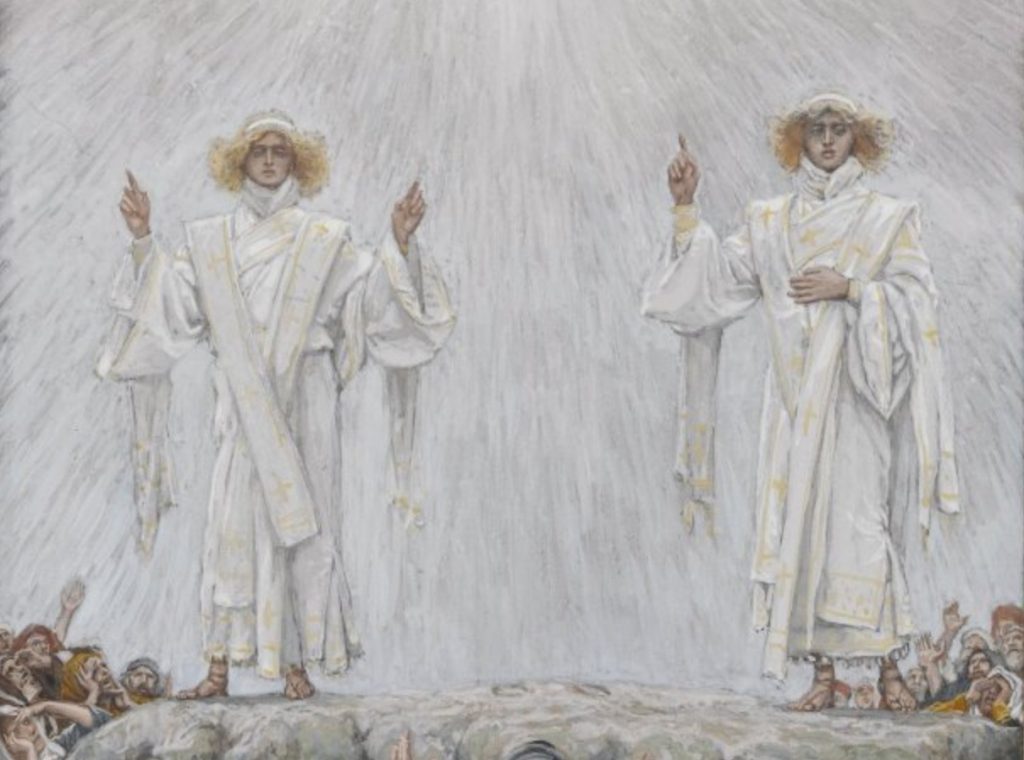
By Fr. Damian Day, O.P.
This article originally appeared in Dominicana and is reprinted with permission.
Christians have their head in the clouds. We can say this because Christ is “the head of the body, the church” (Col 1:18) and “we are members of his body” (Eph 5:30; cf. 1 Cor 12:12-27). This head of ours, scripture tells us, “was lifted up, and a cloud took him from [our] sight” (Acts 1:9).
Having our head in the clouds doesn’t mean we are decapitated, however—Christians don’t run around like chickens with their heads cut off. After all, nothing can separate us from Christ (cf. Rom 8:35-39)—so neither could his ascension, which is “the direct cause of our [own] ascension” and “the cause of our salvation” (ST III, q. 57, a. 6).
Where the head has gone, the members must follow. At the Last Supper, Jesus told his apostles, “I go to prepare a place for you” so “that where I am you may be also” (John 14:2-3). Sitting at God’s right hand (Col 3:1), Jesus is setting a place for us. With his ascension, heaven has opened up its gates to our humanity.
But Jesus doesn’t sit idly reclining on his heavenly throne waiting for us to catch up with him. He is at work drawing us up after him. Jesus told Mary Magdalene, “I am ascending to my Father and your Father” (John 20:17). Through baptism into the only begotten Son we become children of the heavenly Father. Christ, our brother and great high priest, “always lives to make intercession for [us]” (Heb 7:25). He eternally presents his risen humanity that still bears the glorious marks of his passion to our beloved Father. “God so exalted human nature in Christ,” says St. Thomas Aquinas, in order that “He may take pity on them for whom the Son of God took human nature” (ST III, q. 57, a. 6).
Since Christ the head “and the members are as one mystic person,” however, we have actually ascended with him already (ST III, q. 48, a. 2, ad. 1). Through baptism we participate in and are incorporated into the mysteries of Christ’s life: “As in Christ Crucified we died to sin, as in the risen Christ we rise to the life of grace, so too, we are raised up to heaven in the Ascension of Christ” (Fr. Gabriel of Saint Mary Magdalen, O.C.D.). Charles Wesley’s hymn “Christ the Lord is Risen Today” captures the drama of our participation:
“Soar we now where Christ has led, Alleluia!
Following our exalted Head, Alleluia!
Made like him, like him we rise, Alleluia!
Ours the cross, the grave, the skies, Alleluia!”
Because of our baptism, we no longer live a purely horizontal, earthbound life. Clinging to Christ as he cleaves the skies, we are swept up to heaven and set down at God’s throne: “For you have died, and your life is hid with Christ in God” (Col 3:3). This movement marks our transformation in Christ’s life: “even when we were dead through our trespasses, [God] made us alive together with Christ (by grace you have been saved), and raised us up with him, and made us sit with him in the heavenly places in Christ Jesus” (Eph 2:5-6). As one with Christ, we have already ascended, our life resting secure in the bosom of the Father “even though what is promised us has not yet been fulfilled in our bodies” (St. Augustine, Sermon on the Lord’s Ascension).
The Feast of the Lord’s Ascension provides us the opportunity to dwell upon and grow in this mystery of our ascended life. Saint Augustine calls us to enter into the mystery of the day: “Why do we on earth not strive to find rest with him in heaven even now, through the faith, hope and love that unites us to him? While in heaven he is also with us; and we while on earth are with him…we can be there by love.” Love draws us to what our hearts treasure. As our Lord said, “where your treasure is, there will your heart be also” (Matt 6:21). So Augustine encourages us, “let our hearts ascend with him.”
For our hearts to ascend and take their seat beside the one we love—this is contemplation. Since our destiny and our very life sit in glory, “seek the things that are above, where Christ is, seated at the right hand of God. Set your minds on things that are above, not on things that are on earth” (Col 3:1-2). The ascension lifts our drooping heads and heavy hearts up beyond the clouds. This isn’t a flight of fancy or escapism, but rather the gift of a God’s-eye view of reality. It is a glimpse of the source and goal of our life so that we might live here on earth in the light of heaven. As we gaze with love upon our ascended Lord, we might well ponder in our hearts with the Psalmist:
“What else have I in heaven but you?
Apart from you I want nothing on earth.
My body and my heart faint for joy;
God is my possession for ever.” (Ps 73:25-26)
✠
Image: James Tissot, The Ascension







